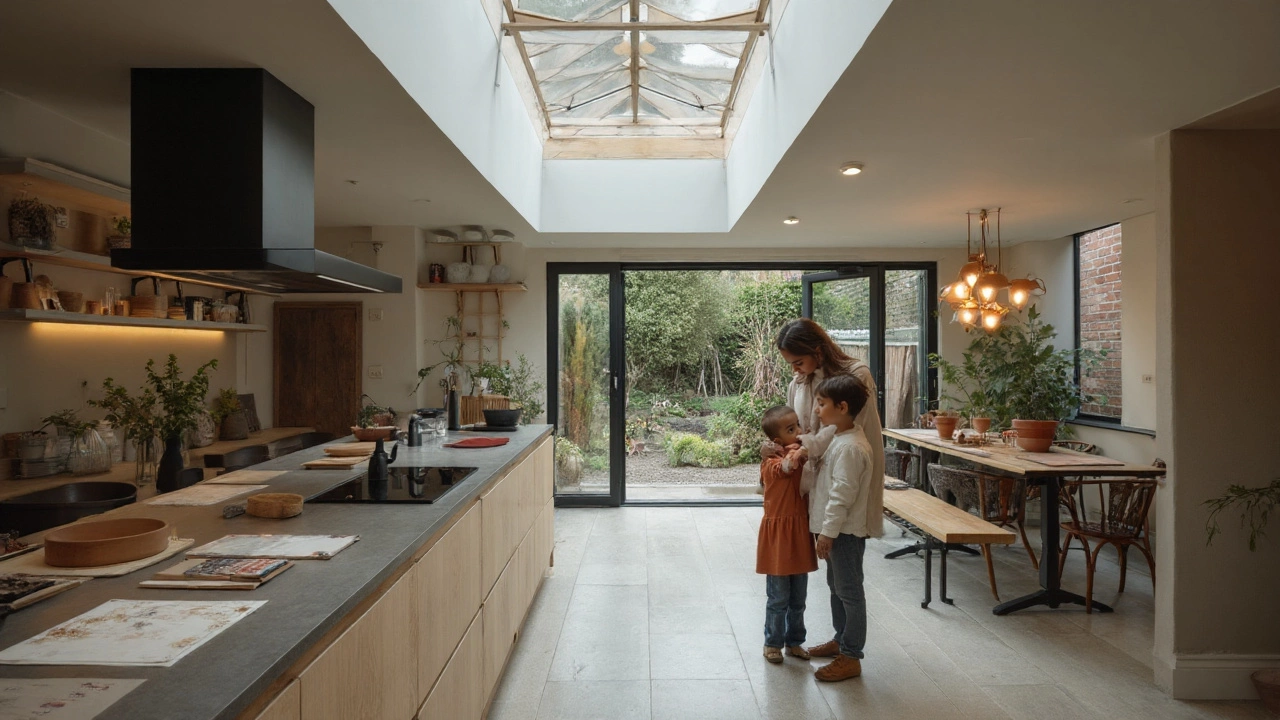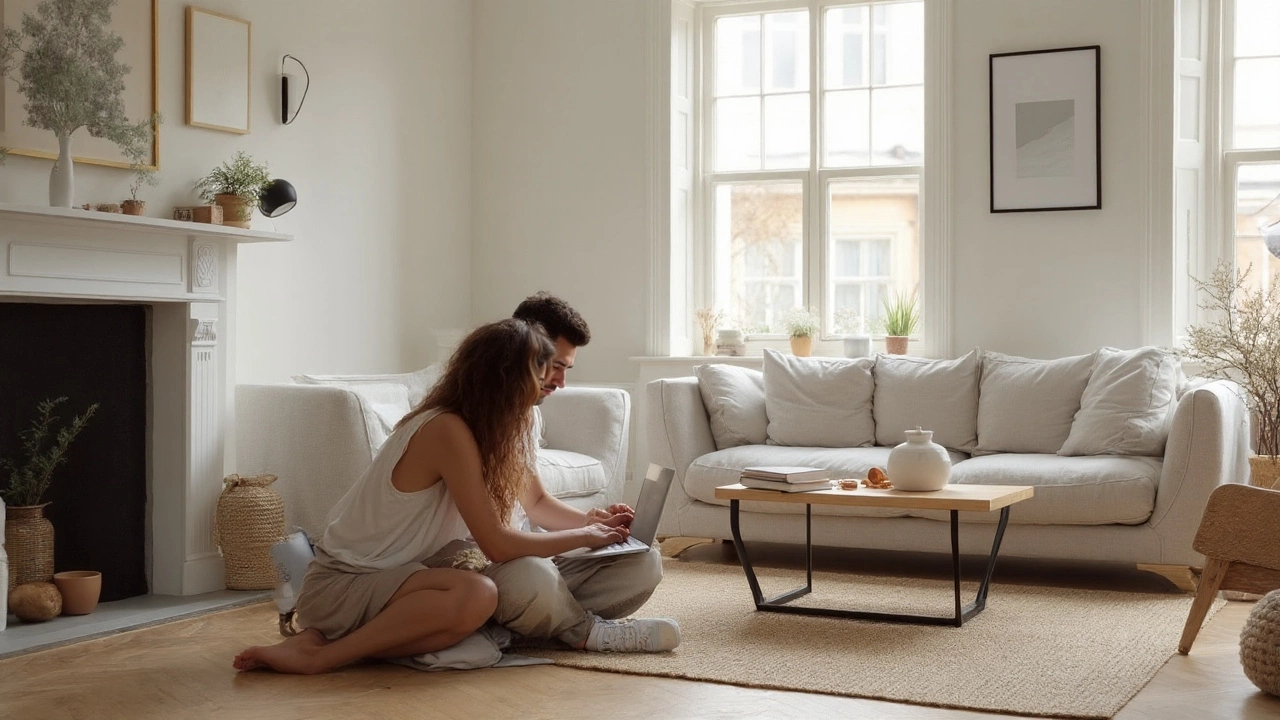TL;DR: What Modern Decor Looks Like
Clean lines, honest materials, and calm spaces. That’s the heart of modern decor. It’s not cold or empty; it’s edited, practical, and built around light, proportion, and texture. Expect simple silhouettes, low visual noise, neutral bases, and a few high-impact pieces.
- Shape: Straight lines and gentle curves; no busy ornament.
- Color: Neutral base (white, warm grey, beige, ecru) with one accent; subtle contrast, not high drama.
- Materials: Timber, wool, linen, stone, matte metals; fewer, better finishes.
- Layout: Airy and purposeful-negative space is used on purpose.
- Lighting: Layered (ambient, task, accent) with slim profiles and warm-white bulbs.
If you’re picturing a space that feels calm yet grounded-think walnut, wool, soft white walls, one strong artwork, and a low-profile sofa-you’re on the right track.
How to Build a Modern Room Step by Step
Modern isn’t a shopping list; it’s a set of choices that make the room feel clear and balanced. Use these steps and rules of thumb to get there without second-guessing every decision.
1) Read your light and set the mood
- In Australia, north-facing rooms get generous sun. You can go cooler on the whites (neutral white, not blue) and still feel warm.
- South-facing rooms run dimmer and cooler. Choose warm whites and creamy neutrals to keep them from feeling flat.
- Rule of thumb: 2700-3000K bulbs for living and bedrooms, 3000-3500K for kitchens. Aim for about 150-300 lux for living rooms and 500 lux for task zones (bench tops, desks), based on common residential lighting targets used by the Illumination Engineering community.
2) Define your base palette
- Color ratio that works: 70% light neutral, 20% mid-tone, 10% accent. Or keep it tonal: sand, taupe, oak, black metal.
- Paint picks that behave: Warm whites with a soft base (think Dulux Australia warm whites) flatter both bright and dim rooms and hide scuffs better than stark gallery white.
- Limit accent colors to one or two. Think moss, rust, deep blue, or charcoal-saturated but muted.
3) Edit your materials to three core finishes
- Pick one timber tone (oak, walnut, blackbutt), one metal (brushed black or stainless), and one stone/ceramic (honest, matte, not glossy). Mixing too many tones kills the calm.
- Texture matters: wool, bouclé, linen, and ribbed weaves bring warmth without prints.
- Choose matte or satin over high gloss. Gloss reflects visual clutter; matte diffuses it.
4) Choose furniture with clean geometry
- Sofa: low to medium back, straight arms or soft curves, tight upholstery or simple cushions. Avoid tufting and heavy skirted bases.
- Tables: thin tops, straight legs, round or rectangle with a thin edge. Avoid ornate turned legs.
- Storage: flat-front cabinetry, push-to-open or discreet pulls. Wall-hung where possible to lighten the look.
5) Nail scale and spacing
- Clearances: Aim for 800-900 mm main walkways; 400-500 mm between sofa and coffee table.
- Rug sizing: Front legs of major seating on the rug. Quick formula: rug width ≈ sofa length + 300-500 mm.
- Art height: Center at ~145 cm from floor (museum rule of thumb). Works in most rooms.
- Curtains: Mount 100-150 mm above the window and run them wide to make windows feel larger. Use a simple ripple fold or S-fold in linen blend.
6) Layer your lighting like a pro
- Ambient: a dimmable ceiling light or track.
- Task: a slim floor lamp by the sofa or an under-cabinet strip in the kitchen.
- Accent: a narrow-beam spotlight for art or a table lamp with a fabric shade for softness.
- Keep profiles slim, finishes consistent, and bulbs warm-white. Dimmers are worth every dollar.
7) Style with restraint
- Books + bowls + branches. Three is a tidy stack. Leave empty space on shelves.
- Cushions: solids or subtle textures; 2-3 patterns max, all within the same palette.
- Greenery: one sculptural plant or a simple branch in water. Skip fussy arrangements.
8) Choose durable, honest pieces
- Upholstery: wool blends, performance linen, or high-quality microfibre for kids and pets.
- Rugs: woven wool with a tight loop or low pile; flatweaves are easier to clean.
- Joinery: plywood or solid timber with real veneer. Avoid peel-and-stick foils near heat or moisture.
9) Keep it healthy and sustainable
- Paints: look for low-VOC and GECA-certified lines in Australia.
- Timber: FSC or PEFC certified where you can.
- Ventilation: operable windows and reverse-cycle systems with clean filters help keep indoor air clearer.
Modern decor is as much about what you skip as what you add. If an object doesn’t have a job-use or beauty-it probably doesn’t belong.

Modern Decor Examples, Materials, and Costs
Here’s how the look comes together room by room, with materials that hold up in Australian homes and budgets that won’t ambush you.
Living room (calm and grounded)
- Palette: warm white walls, oak timber, black metal accents, one deep moss or rust accent.
- Furniture: low-profile sofa in oatmeal wool blend, oak coffee table with a thin top, slim black floor lamp, flat-weave wool rug.
- Detail: one large artwork or a single statement sculpture. Avoid gallery walls unless they’re clean and consistent.
- Common mistake: rug too small. Size up so the front legs of your seating sit on the rug.
Bedroom (quiet, soft edges)
- Palette: sand and ecru with charcoal or inky blue accents.
- Furniture: timber bed with a simple headboard, two floating bedside shelves, linen duvet, wool throw.
- Lighting: warm bedside lamps or wall sconces with fabric shades; dimmable.
- Detail: a single bench or ottoman in bouclé or leather; no heavy dressers unless storage demands it.
Kitchen/Dining (clean, functional)
- Cabinetry: flat panel in warm white or pale timber; handles minimal or integrated.
- Benchtops: engineered stone in a soft grain, or stainless for a chef’s look. Keep thickness slim.
- Backsplash: large-format tile or slab to reduce grout lines.
- Dining: rectangular or round timber table, slim upholstered chairs; a single linear pendant or 2-3 small pendants over the table.
Bathroom (serene, low maintenance)
- Tiles: large-format porcelain in soft grey or beige; avoid busy mosaics everywhere. One feature zone is enough.
- Vanity: wall-hung timber-look or painted, thin stone top, simple basin.
- Tapware: brushed stainless or black with simple geometry; stick to one finish across the space.
Materials that feel right-and why
- Timber: oak, ash, walnut, blackbutt-reads warm and timeless. Choose matte or oil finishes.
- Stone and porcelain: keeps pattern quiet; pick honed or matte for a soft look.
- Metals: brushed stainless, blackened steel, or aged brass. One or two finishes, max.
- Textiles: wool, linen, cotton canvas, leather. Skip heavy prints; lean on weave and texture.
- Glass: clear or reeded for privacy without visual clutter.
What it costs (Australia, 2025 ballparks)
These are realistic ranges from Melbourne retailers and joinery quotes in 2024-2025. Prices swing with quality and supply, but this gives you a grounded starting point.
| Item (Living Room) | Low | Mid | High |
|---|---|---|---|
| Sofa (3-seater) | $1,200-$1,800 AUD | $2,000-$3,500 AUD | $4,000-$8,000 AUD |
| Rug (2x3 m wool) | $350-$700 | $800-$1,400 | $1,800-$3,000 |
| Coffee table (timber) | $250-$600 | $700-$1,500 | $1,800-$3,500 |
| Floor/table lamps | $150-$400 | $450-$900 | $1,000-$2,500 |
| Media unit (2-3 m, flat-front) | $500-$1,000 | $1,200-$2,500 | $3,000-$6,000 |
| Art (1 large piece) | $200-$600 | $700-$2,000 | $2,500-$8,000+ |
| Soft furnishings (cushions/throws) | $120-$300 | $350-$700 | $800-$1,500 |
Custom joinery note: expect $1,200-$3,000 per linear metre for wall-hung cabinets in a modern style, depending on materials and hardware.
Smart swaps that keep the look and save money
- Engineered timber instead of solid timber in low-wear areas.
- Porcelain tile with a stone look instead of real stone in wet zones.
- Ready-to-assemble flat-front cabinets with upgraded hardware (soft-close) for a clean, modern facade.
- One statement light + budget downlights on dimmers rather than many pricey fixtures.
Where people slip up
- Confusing modern with contemporary. Modern skews timeless and minimal; contemporary is “of now” and can be trendier.
- Too much grey. Layer warmth with timber and textured textiles.
- Too many finishes. Cap it at three core finishes and repeat them.
- Undersized rugs and art. Modern needs confident proportions.
- Gloss overload. Use matte for walls, satin for timber, and brushed metals.
Cheat Sheets, FAQs, and Next Steps
Modern decor cheat sheet (pin this)
- Color rule: 70/20/10 or tonal neutrals with one muted accent.
- Finishes: three core finishes across the room. Repeat them.
- Lighting: ambient + task + accent. Warm white bulbs. Dimmers.
- Scale: big rug, large art, low-profile furniture. Leave negative space.
- Hardware: keep lines straight and details thin or integrated.
- Textiles: wool, linen, leather; texture over print.
- Sustainability: low-VOC paints, FSC timber, long-warranty appliances and fixtures.
Quick decision helpers
- Not sure about a color? Sample it on large A3 boards and move them around for two days in different light.
- Can’t choose a timber? Match the largest piece in the room (flooring or major furniture) and vary the tone by 1-2 shades for depth.
- Unsure on a coffee table shape? Round suits tight walkways; rectangle suits long sofas and narrow rooms.
Mini-FAQ
Is modern the same as mid-century modern?
Not quite. Mid-century modern is a specific period (roughly 1945-1969) with iconic silhouettes (tapered legs, teak). Modern decor borrows the clean lines but uses a wider material and color range, less retro vibe.
How do I keep it from feeling cold?
Add texture and warm tones: wool rug, linen curtains, timber furniture, warm-white lighting, and a few rounded forms. Texture is your heater for the eyes.
Can modern work in a period home?
Yes. Keep the bones (cornices, fireplaces) and let the furniture be the modern counterpoint. Use flat-front joinery and neutral walls to bridge old and new.
What about kids and pets?
Go for performance fabrics, washable slipcovers, and low-pile wool rugs (they bounce back and hide mess). Choose closed storage for toys and tech.
Do I need expensive pieces?
No. One great piece (sofa or table) sets the tone. Pair it with simple, well-proportioned budget items and clean styling.
Room-by-room quick checklist
- Entry: slim console, large mirror, 1 tray for keys, concealed shoe storage.
- Living: big rug, low sofa, simple coffee table, one statement art piece, floor lamp, tidy media unit.
- Dining: table with clean edges, 4-6 slim chairs, one linear pendant, zero clutter centerpiece.
- Bedroom: uncluttered bed, 2 matching lamps or sconces, floating bedsides, soft rug underfoot.
- Bathroom: wall-hung vanity, large-format tiles, one metal finish, simple mirror cabinet.
Troubleshooting by scenario
I rent and can’t renovate
- Use peel-and-stick matte film on cabinet fronts and wardrobe doors; choose a warm neutral.
- Swap harsh bulbs for 2700-3000K LEDs. Add plug-in sconces and floor lamps.
- Go big on a rug and art to shift the vibe without paint.
My space is small
- Pick a sofa on legs to show floor. Glass or thin-top tables reduce visual bulk.
- Choose a round dining table (seats 4-5) to ease circulation.
- Mount shelves higher and leave some shelves empty to create breathing room.
Family home, heavy use
- Closed storage with flat fronts hides toys fast.
- Performance fabric or leather grain hides wear; removable cushion covers help on laundry day.
- Choose darker-toned oak or walnut, which camouflages nicks better than very pale timber.
Budget is tight
- Spend on the sofa and lighting. Save on side tables, cushions, and simple shelving.
- DIY: repaint walls in a warm white and swap visible hardware to matte black or stainless.
- Hunt secondhand for timber pieces with clean lines; refinish in matte oil.
Style proof: a 60-minute modern reset
- Declutter surfaces. Leave 30-40% of each shelf empty.
- Rearrange seating around a larger rug; pull furniture off walls by 100-150 mm.
- Set one focal point (art or sculptural lamp). Remove competing accents.
- Swap cool bulbs for warm. Add a dimmer plug for lamps.
- Group decor in threes: a book stack, a bowl, and a branch in a vase.
Modern decor isn’t a trend chase. It’s a promise: less noise, more intent, and rooms that breathe. If you stick to clean lines, warm textures, and a disciplined palette, your space will feel calm now and age well later.


